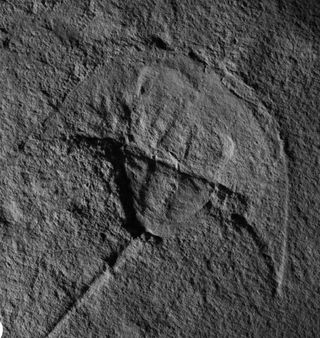Horseshoe Crab Fossil from a Long Time Ago Named After Darth Vader

This story was updated Dec. 8 at 12:25 p.m. EST.
The fossil of an ancient "Star Wars" Sith Lord from a long time ago, but not quite so far, far away, was recently unearthed, a new study reports. Fossilized remains of an extinct species of horseshoe crab, named after Darth Vader because the animal's bizarre shape resembles the "Star Wars" character's iconic helmet, were discovered in Idaho.
Researchers dubbed the newly discovered, 4-inch-long (10 centimeters) horseshoe crab Vaderlimulus tricki. The species name tricki honors the man who found the fossil, Trick Runions, who is part of the citizen science Dinosaur Trackers Research Group at the University of Colorado Denver.
The specimen marks the first time a horseshoe crab from the Triassic, a period lasting from 251 million to 199 million years ago, has been found in North America, the researchers said. The only other fossil records of horseshoe crabs (Xiphosurida) from the dinosaur age of North America are of three scientifically named specimens from the Cretaceous, a period that lasted from 145 million to 66 million years ago, the researchers said in the study. [Gallery of Fantastic Fossils]
At 245 million years old, the newfound crab is old, but other fossils of horseshoe crabs are even older, with some dating to roughly 470 million years ago, the researchers said. Intriguingly, the newly discovered creature had "unusual body proportions that give it an odd appearance," study lead author Allan Lerner, a researcher at the New Mexico Museum of Natural History and Science in Albuquerque, New Mexico, said in a statement.

V. tricki's bizarre shape indicates that it belongs to the family Austrolimulidae, which has since gone extinct, the researchers said. Members of the Austrolimulidae family lived in the ocean but were venturing into freshwater areas during the Triassic. They often developed bizarre anatomical features that helped them make that transition, the researchers said.
During its lifetime, V. tricki lived on the western coast of the supercontinent Pangaea. The area the animal inhabited was likely a coastline where freshwater and seawater met, the researchers said.
Sign up for the Live Science daily newsletter now
Get the world’s most fascinating discoveries delivered straight to your inbox.
The research, which marks the efforts of researchers from the New Mexico Museum of Natural History and Science and University of Colorado Denver, was published online Dec. 1 in the journal Neues Jahrbuch für Geologie und Paläontologie – Abhandlungen (New Yearbook of Geology and Paleontology – Essays).
There are just four species of horseshoe crabs known today, and their populations are dropping.
Horseshoe crabs actually are not true crabs, but rather are more closely related to scorpions and spiders.
V. tricki is far from the only species named after a "Star Wars" character. Others include Trigonopterus chewbacca, a tiny, flightless weevil recently discovered in New Guinea, and Tetramorium jedi, an ant species that inhabits the lowland rainforests of Madagascar, Live Science previously reported.
Editor's Note: This story was updated to fix an inaccuracy about horseshoe crab evolution and an error about the number of recovered horseshoe crab fossils in North America dating to the Mesozoic period.
Original article on Live Science.


